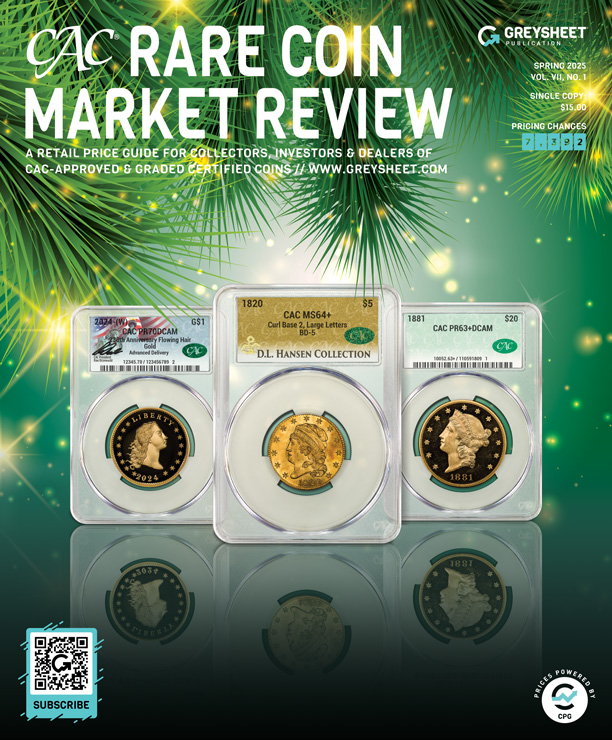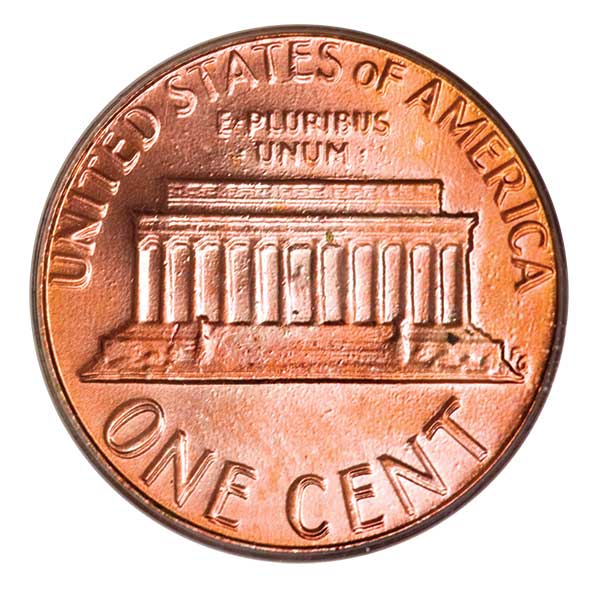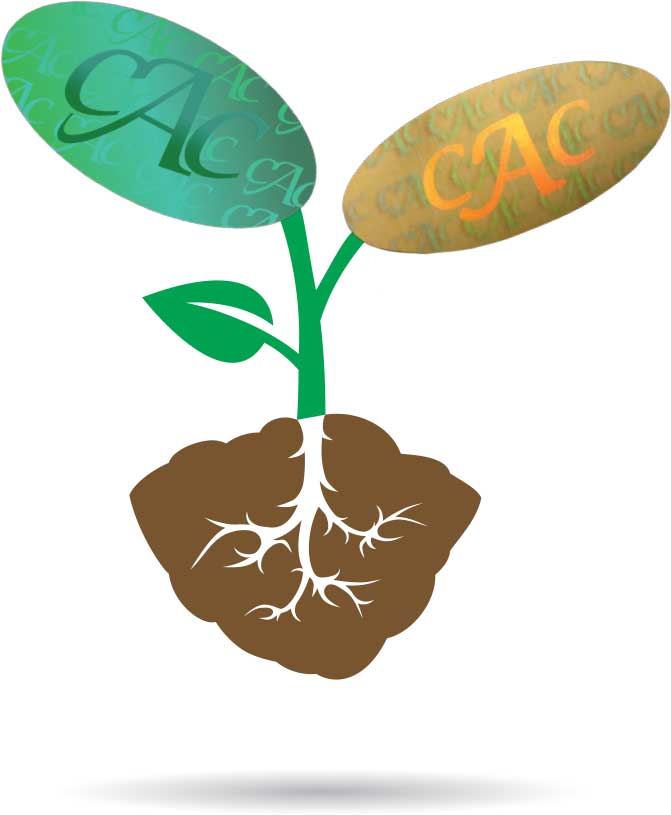An Interview With CAC Founder John Albanese
After as initial partner in PCGS and then founding NGC in 1987 John Albanese has had a long career as a leader in US numismatics. In 2007 he founded CAC, a company that continues to make a large impact on the market.
Magic Beans: How Green & Gold Stickers Sprouted A New Marketplace
For more than four decades, John Albanese has been a numismatic thought leader, bringing innovation to an ages-old hobby and helping redefine how collectors and the marketplace understand the quality and condition of coins. In 1986, Albanese co-founded PCGS, and a year later established his own third-party grading firm, NGC. The creation of those two organizations revolutionized the coin industry, providing industry standards for consistent grading and offering a greater sense of security to the collectors and dealers who wanted authentic and accurately graded coins. While a novelty at first, the encapsulation of coins rapidly became commonplace.
By the 2000s, tens of millions of coins across the entire spectrums of grade, type, and period found their way into sonically sealed plastic. While NGC and PCGS have maintained the most consistent and rigorous of grading standards of all third-party graders, over time the inevitable happened—some slabbed coins of similar grade were simply better than others. One could place a few coins certified by the same company of identical type, date, and labeled grade and find that, perhaps, one or two really stood out from among the rest. And, invariably, less market receptivity for average or subpar pieces for a given grade could drag down prices for the best examples of the same grade—coins deserving of their own market.
What to do? Albanese had the answer. In 2007, he founded CAC with a mission to help premium-quality coins stand out from the rest by creating a separate market for them. For a fee, CAC evaluates coins slabbed by NGC and PCGS, awarding one of two possible seals of approval for coins of excellent quality and overall outstanding eye appeal for their labeled grade. Pieces determined to be at the top of their class for their grade receive a small green sticker on their slabs. Meanwhile, coins that are undergraded and would still qualify for a green sticker, even if graded one point higher, are bestowed a gold CAC seal.
Albanese’s concept, which early on especially depended on a network of dealers participating in the submission of their better-quality slabbed inventory, caught on quickly across the numismatic industry. In 2008, numismatic expert Maurice Rosen interviewed Albanese about CAC and its mission to revolutionize the slabbed market by stickering the finest coins for their class and giving them a marketplace niche all their own. The market was obviously hungry for what Albanese brought to the table, for within months, his objective was already taking shape. “We know it’s going to be hard but we’re barely in the first inning and have achieved some impressive success,” said Albanese in 2008. “Greysheet bids (sight-seen wholesale bids) are strong since we started, but Bluesheet prices (sight-unseen bids) have not been as strong. We’re already seeing a start to the decoupling we hoped to achieve. We expect volatility in prices; what we shouldn’t expect is volatility in grading. That’s our mission.”
To extrapolate Albanese’s baseball references, CAC has hit plenty of home runs over the last 11 years. The coins CAC has labeled, bearing shiny bean-shaped green or gold stickers, have performed well in both in day-to-day trading as well as in high-profile auction appearances. “Beaned” coins have performed remarkably well, trading for premiums ranging from about 10% to 90% and even more, as opposed to their identically graded but non-CAC counterparts. Prices for many of the most actively traded CAC coins have also been increasingly represented in The CDN Monthly Greysheet, further reflecting the fact that CAC coins have built a solid niche in the market.
CAC has now stickered more than 1.1 million coins with a combined insured valued of $5.5 billion and has an ever-growing network of member dealers. The success of CAC and the market’s overwhelmingly positive response to its mission has proven grade really does matter, and not just dependent on what a label says, but also the unspoken “letter grade” relative to the numeric one actually assigned, I.E. “A” (high end), “B” (solid for the grade), and “C” (lower end).
It goes without saying that CAC has grown over the years, but has its mission evolved? How has the market responded to the growing dominance of CAC over the last decade? What types of coins are being submitted to the firm today? Among CAC coins, what are presently the best values for an investor? Albanese took a few minutes from his busy schedule to discuss where CAC is today and share what the future holds for this buzzing area of the market.
Q. Over the last decade, how has your mission come to fruition and has it changed at all since 2008?
A. When PCGS and NGC added plus grading (in 2010), I think it validated our mission statement—that there is a difference in coins, and there really is a such thing internally in the business as an ‘A,’ ‘B,’ and ‘C’ grade. So, that gave us a great shot in the arm. When that happened, our submissions essentially doubled from around 4,000 coins per month to around 10,000.
Q. That is certainly a testament to how the collective marketplace believes in your mission, too. What does growth at CAC look like now?
A. As far as the company’s growth, we’ve grown from a few hundred members to a few thousand. We still have a waiting list, but we let a few members in every week. We try and have controlled growth. It’s not a scalable business, so it’s not sexy in terms of growth. Analogous to a baseball game, I think CAC is probably in the sixth inning, maybe even later? I think we’re past our peak right now in terms of stickering coins of significance.
Q. Interesting… So, what types of coins are you receiving more of these days? How has the supply of unstickered material shifted and what does this mean for rarer beaned coins in the marketplace?
A. We’re still getting plenty of coins, generic gold, a lot of cheaper coins such as Lincoln pennies from the 1940s and that type of thing. But as far as coins we like to make a market in, it’s very disappointing. I find even coins that were somewhat available eight or ten years ago, like 1911-P Saints in MS65—always a tough coin to find stickered but one for $16,000 or $17,000, there was always one on the market somewhere. Now they’re around $22,000 or $23,000 wholesale but they’re unavailable. Maybe for the first five or six years of our existence, we stickered around 90% of what’s on their pop report, and since then it’s an occasional coin. It’s leading me to believe that, I don’t want to say we’ve seen all the coins—we haven’t seen all the coins—but in terms of significant coins, we’ve seen a large majority of what we’re going to see. Even coins like the 1911-P Saint in MS65, we still sticker them, but usually it’s a coin we stickered five or ten years ago and now it’s crossed over to another service and restickered, so it comes off the pop report. Or, it has a plus grade and we restickered it. As you know, we don’t recognize the plus grades, so if the coin was an MS65 1911 Saint and it gets a plus now, we automatically resticker.
Q. Does it surprise you how few quality specimens exist for certain issues?
A. It really hasn’t surprised me, and it’s similar to my experience at NGC. When NGC was first formed in 1987, and PCGS in 1986, I do remember during the first five years or so just amazing collections or groups of coins coming in. And as time went by, it just diminished and diminished. And there’s always going to be bags of 1880s Morgan dollars and European hoards of 1924 Saints in MS62, but I didn’t disrupt my life and start CAC to look at MS62 Saints and bags of dollars! It’s really for the more prominent coins and the coins where I think the ‘A,’ ‘B,’ and ‘C’ really matter. It doesn’t really matter that a 1924 Saint in MS62 wasn’t stickered or not.
Q. In 2008, you told Maurice Rosen that coins of nickel composition had a higher chance of stickering than gold coins such as Saints. Is this dynamic something you’ve found has remained the same over the years?
A. A proof 3-cent nickel or proof V nickel. These are made on a very hard metal—they never circulated—and it’s very difficult to pick up a hairline on a three cent nickel compared to a Barber dime, as the silver is soft. So, it’s just natural the nickels had a higher sticker rate. They’re very well preserved and have higher rims, which protect the surfaces. Now as you get into larger coins, like a Saint-Gaudens or a Liberty $20, or a Morgan dollar, you have much larger coins that were stored in bags over the years, and those tend to be abused more. So, generally speaking, it’s sort of common sense that those would have a lower amount of “A” and “B” coins.
Q. How does the market absorb low-end coins?
A. It seems to me you get typical complaints from dealers that these coins are sloshing around at auctions, and that the same coins at coins shows are making their rounds. They just don’t seem to come off the market. And that’s why I’ve always said, I think what we see out there in the marketplace is not a fair representation of what’s coming out of the grading services. Consider what’s happening on the bourse floor… If you’re a veteran dealer, you’re going to take a select piece and sell it to your clients. And you’re going to bring your lower-end coins to a coin show to wholesale them. So, again, it’s really not representative of what’s coming out of the marketplace. I think what’s coming out of the grading plant is really nice overall, but maybe the bottom 10% is what’s we’re seeing on the bourse floor—and everything has to have a bottom 10%, right? There’s a home for everything, and from what I’ve understood, it’s quite easy to sell a coin that’s a C-grade coin if it’s priced right. There are people who want to buy bargains, whether it’s an off-color diamond or a sweater with a little flaw that you can buy for $2. There’s a buyer for everything. We don’t want to demean the lower end of the market, but it is a different buyer. And, that’s what great about coins compared to other collectibles. You can bring to a dealer a Bust dollar that has a hole in it and has been in a fire and get an offer. Try doing that with an antique or a painting. Coins are extremely liquid—more liquid than any other collectible out there. That’s what helps make this such a great hobby.
Q. The marketplace has demonstrated confidence in CAC-stickered coins as market values values have done well compared to non-CAC counterparts. Do certain stickered issues seem to have benefitted more than others in terms of price premiums?
A. I think overall you could look at auction results and see the CAC coins have sold for premiums. From what I hear from dealers, they say CAC is more important in gold than for copper.
Q. Is there a part of the market (for stickered coins) you feel is undervalued right now? If someone wanted to invest $500 or $1,000, what should they be looking at?
A. I think collectors and investors are alike. When I see the price of gem gold and silver classic commemoratives, I just have to scratch my head. I have to look at the prices again and ask ‘is that real? How’s that possible?’ It’s just disbelief in looking at the prices of gem gold and silver commemoratives almost across the board.
Q. How big is the grading team at CAC?
A. We have only one finalizer, and that’s myself. Then we have three all-star graders who have been with me since I was with NGC in the late ‘80s and early ‘90s. These guys are Bill Wetzler, Bill Shamhart, and Steve Blum.
Q. In this interview we’ve done a lot of looking back over the last 11 years both in terms of your mission and your observations of the marketplace’s response to CAC, but what lay ahead? What do the next 11 years hold for CAC?
A. I’d say as far as future growth, there’s going to be a time when I think submissions are really going to diminish, or we will no longer sticker coins. That day is coming, I don’t know when. We have a very large capital base, large customer base, and we’d just become a market maker in stickered coins. And at that point, the population would be static. We have tremendous resources, and I spend 90% of my day looking at coins and 10% of my day making a market in coins. So, if that came to be where we were no longer stickering coins then I’d spend 100% of my day making markets.

Download the Greysheet app for access to pricing, news, events and your subscriptions.
Subscribe Now.

Subscribe to CAC Rare Coin Market Review for the industry's most respected pricing and to read more articles just like this.
Related Stories (powered by Greysheet News)
View all news
Lincoln cents are arguably the most popular United States series around. They're perhaps the most widely collected American coin and countless collectors love Lincoln cents, and they're often seeking well-known rare wheat pennies such as the 1909-S VDB, 1911-S, 1914-D, 1924-D, and 1931-S.

It's hard to imagine the numismatic world without Heritage Auctions. And, yet, until only little more than a decade ago, Heritage was a growing firm that handled much volume, but had not yet dropped the hammer on a seven-figure coin. The company's colorful story goes back to 1976, when Steve Ivy transformed his Dallas coin business into a numismatic auction firm.

For more than four decades, John Albanese has been a numismatic thought leader, bringing innovation to an ages-old hobby and helping redefine how collectors and the marketplace understand the quality and condition of coins.








Please sign in or register to leave a comment.
Your identity will be restricted to first name/last initial, or a user ID you create.
Comment
Comments